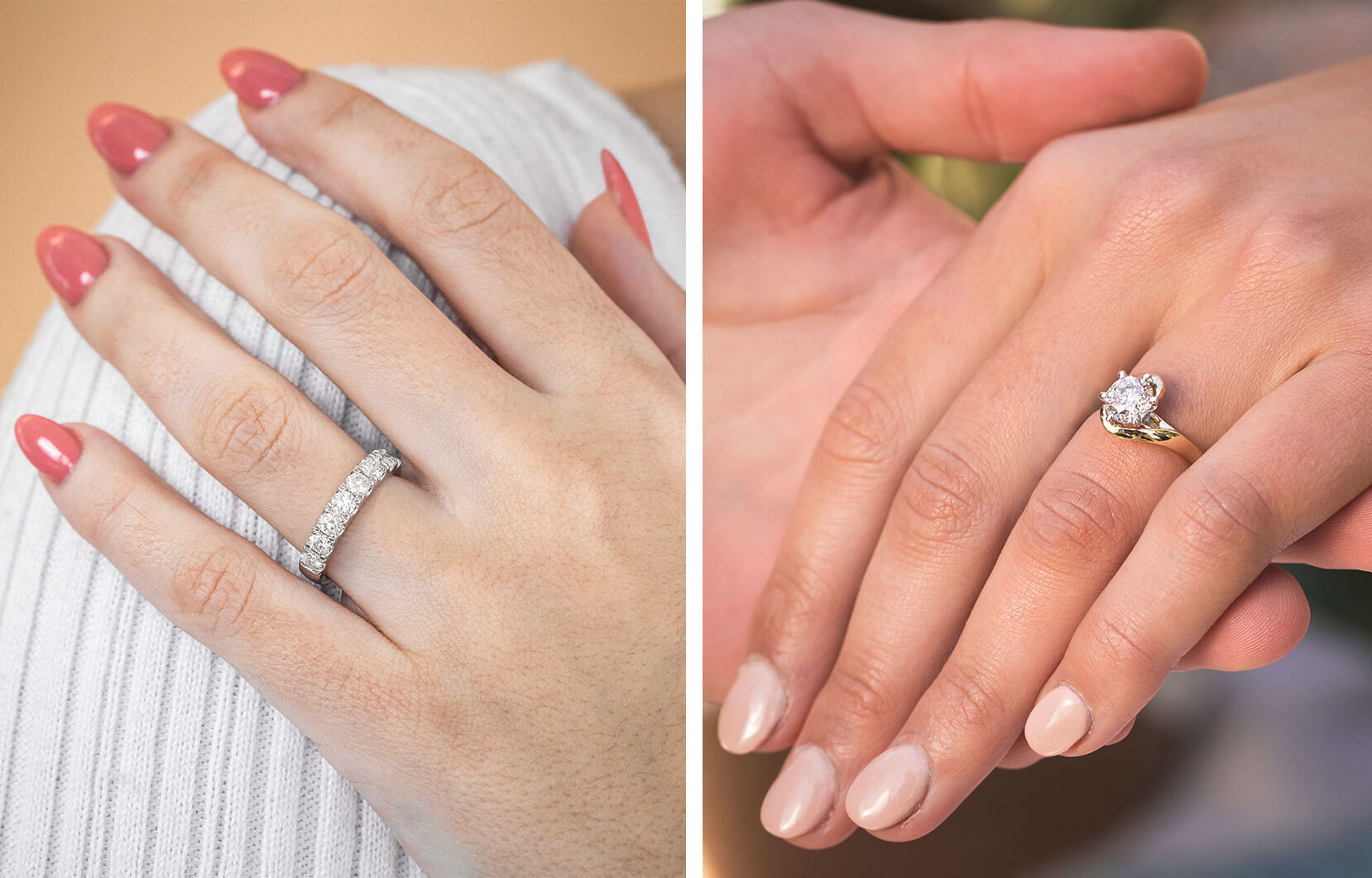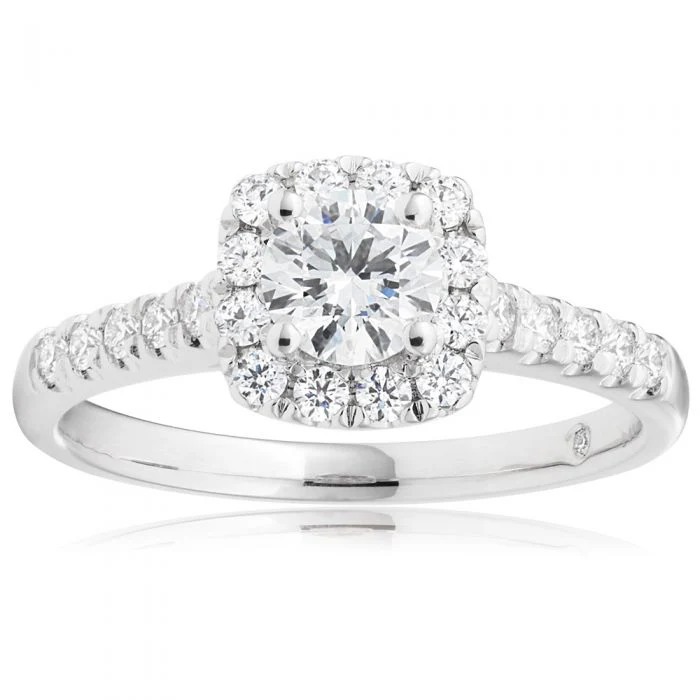When shopping for engagement rings or picking out your forever piece, the second most important thing you will need to consider behind what diamond cut and carat you are looking for is the kind of setting you would prefer. Choosing the right setting for your diamond ring or that pair of earrings you have been eyeing isn’t just limited to picking out a style you like as you also have to consider the metal you want your jewellery to be. Regardless of what you are shopping for, whether it be chains or a diamond engagement ring, choosing the right hue and metal for your piece’s setting is extremely important. This is not only because it ensures the longevity of your jewellery, but it also allows for it to seamlessly fit into your wardrobe and lifestyle.
From classic yellow gold jewellery and brass to sleek sterling silver and stainless steel, there are countless options for jewellery settings. However, when it comes to bridal sets and diamond rings, gold and platinum jewellery remain the two most popular choices. Platinum and gold jewellery are not only favoured for their timelessness, durability and the way that they make your diamonds stand out more. Unfortunately, this does not make choosing your setting any easier, as while you may prefer the hue of a certain type of gold, you may also like the undisputable elegance of platinum too.
This is why we are weighing up the pros and the cons of platinum vs gold jewellery to determine once and for all, what metal makes for the ideal engagement setting.
Overview:
- Platinum vs Gold Jewellery - What's Better?
- Platinum Jewellery Pros & Cons
- Gold Jewellery Pros & Cons
- The Verdict
Platinum vs Gold Jewellery - What's Better?
For decades, both platinum and gold rings have been the prime choice when it comes to bridal jewellery. This is because gold and platinum rings are not only the height of luxury but are also guaranteed to stand the test of time. Naturally, this can make the task of shopping for wedding rings, engagement rings and even eternity rings a very tedious one. But, much like everything else in life, platinum and gold jewellery both have their fair share of pros and cons that may impact the choice you may make when picking out your engagement ring setting.

Platinum Jewellery Pros & Cons
Fifteen times rarer than gold, platinum jewellery is often regarded as “King of the Metals” due to both its rarity and its quality. Consisting of multiple variations of the natural element, 80% of the world’s platinum comes from South Africa and the Sudbury Basin of Canada. It is formed deep within the earth’s crust in what is known as ultra-mafic ingenious rocks when minerals are eroded from their original spot and then carried by water elsewhere in a process known as stream bed mining or alluvial mining. It is often mistaken for silver jewellery due to their similar appearance, although, silver is much softer and therefore more malleable than the incredibly sturdy platinum. This highly prized mineral has a lot to offer those that opt for a platinum engagement ring, particularly luxury and durability, however, that is not to say it doesn’t come with its drawbacks.

Platinum Jewellery Pros
Platinum jewellery makes up one of the very few types of fine jewellery and accessories where the precious metal makes up 95% of the item’s foundations, this is because unlike other metals which can be quite soft and delicate-platinum is incredibly durable and hardwearing. This naturally makes it a popular choice for those that work with their hands and therefore requires a setting that isn’t going to be vulnerable to any knocks, scuffs or scratches. The high purity level in platinum jewellery pieces is also suitable for those with sensitive skin as it is hypoallergenic and so it doesn’t contain alloys such as nickel which is prone to causing allergic reactions. Another benefit to the high purity level of platinum jewellery is that it is colourless, so it won’t alter the appearance of your diamonds. Not to mention, it does not leave it susceptible to corrosion or tarnishing.
FLAWLESS CUT PLATINUM DIAMOND RING 0.5-0.54 CT

$3,099.00
Elevate your style with our Flawless Cut Platinum Diamond Ring, featuring a mesmerising 0.5-0.54 Ct diamond. Meticulously crafted with precision, this ring embodies the epitome of luxury and sophistication. The flawless cut of the diamond ensures maximum brilliance and sparkle,… read more
Platinum Jewellery Cons
Unfortunately, while the high purity level of platinum jewellery has led to a lot of beneficial properties, it is also the metal’s downfall in some ways. One of the pitfalls that come from platinum vs gold is price. Due to its purity, platinum is significantly more expensive than gold. According to Brides.com, platinum is between 40 and 50% more expensive than gold. This is not only due to its density but also due to its rarity. This factor alone may deter people from purchasing an item featuring a platinum setting, especially if you are already forking out a significant amount of money for diamonds or gemstones. And while the density of platinum jewellery arguably makes it more durable and hardwearing than some of the other metals commonly used for jewellery settings, a huge disadvantage to this is that it makes it heavier and therefore not suitable for everyone, especially those with shorter and daintier hands.
FLAWLESS CUT PLATINUM DIAMOND HALO RING

$2,779.00
A classic design, this Flawless Cut Platinum Diamond Ring is a real showstopper. Featuring the unmissable sparkle of flawless cut diamonds. Every diamond from the Flawless range has the beautiful pattern of hearts and arrows which is a sign that… read more
Gold Jewellery Pros & Cons
Often regarded as other-worldly given its unique and galactic origins, gold jewellery is by far one of the most popular metals most commonly associated with jewellery. Comes in multiple hues ranging from yellow gold, which is perhaps the most traditional as well to rose gold which has a more pinkish tone to white gold which is often regarded as an alternative to silver and platinum, people often favour gold for its versatility and the warmth that it brings to their look. Thought to be produced as the result of ‘nuclear fusion’-a process that occurs during a supernova when neutron stars collide, causing heavy elements to form, gold is not as rare as platinum but is a lot pricer than silver, however, it is often produced from metal alloys that can cause its price to vary tremendously. Much like platinum, gold makes an excellent metal for an engagement ring and jewellery settings that aren’t necessarily suitable for everyone.

Gold Jewellery Pros
In the jewellery world, gold is considered an alloy, something that gives the metal a great deal of versatility in terms of style and price. And we’re not just talking about having the option to choose between classic yellow gold, contemporary white gold or feminine rose gold. Gold is an incredibly soft element, meaning that metal alloys are added to add some sturdiness and durability. A major benefit of this is that it enables the shopper to choose between 9-karat gold which contains 37.5% pure gold, 14-karat gold that has 58.3%, 18-karat which features 75%, 22-karat with around 91.7% and 24-carat gold, which is often regarded as pure gold. This factor offers people not only choice but allows even those looking to spend less the chance to own a piece containing pure gold. With a majority of gold being made from alloys, the metal is naturally more resistant to scuffs, bumps, scratches, dents and even corrosion. However, arguably the biggest gold jewellery pro is that it will forever remain timeless. People have been wearing everything from gold chains and rings to gold earrings pretty much since the days of Ancient Rome and yet it continues to be a fashion-forward choice some thousands of years later.
14CT YELLOW GOLD SOLITAIRE RING WITH 50 POINT DIAMOND

$1,334.00
Embrace classicality with the gorgeous 14ct Yellow Gold Solitaire Ring With 50 Point Diamond. Crafted in the warm tones of 14ct yellow gold that is bold, stylish and timeless, this is a ring that you will treasure for years to… read more
Gold Jewellery Cons
While gold jewellery will always be one of the most versatile and stylish choices when you’re in the market for a new piece, that is not to say it is a choice that will benefit everyone. With gold being an alloy, it often contains metals that are not suitable for wear for those that suffer from contact dermatitis. And while you can buy hypoallergenic gold, there is always the possibility that it contains nickel. White gold and rose jewellery are completely off-limits to people with nickel allergies due to the high levels of the element present to turn gold white and rose-tone respectively. White gold jewellery can also sometimes be a hassle to take care of as it sometimes has to be dipped in rhodium coating to retain its colour and shine. Another disadvantage of gold vs platinum jewellery is sturdiness. While gold jewellery is relatively durable, it can be quite soft and malleable if the gold purity level is higher. This can be an issue if the piece you have contains diamonds and gemstones, or if the item is a ring.
Platinum vs Gold Jewellery: The Verdict
It’s clear that both platinum and gold jewellery have their fair share of benefits and which one is right for you is largely down to style as well as what fits within your lifestyle. For example, those with fairer skin may prefer platinum because gold is too harsh on their complexion. Contrastingly, those with darker and more olive skin may find themselves reaching for more gold hues as warmer tones tend to complement their skin more. But if you are someone who frequently struggles with nickel allergies and sensitive skin, platinum jewellery is likely going to suit you better. If you’re on a very strict budget and would prefer to put the bulk of your jewellery fund into diamonds rather than the setting, gold just may be the right choice for you.













